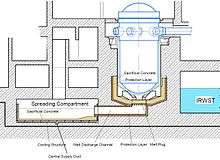Core catcher

A core catcher is a device provided to catch the molten core material (corium) of a nuclear reactor in case of a nuclear meltdown and prevent it from escaping the containment building.
A core catcher is made from a special concrete ceramic to prevent material from trickling through; it is also a cooling mechanism to cool down the core material.[1][2] The core catcher of the European Pressurized Reactor (EPR) has 170 m² expansion area and a mass of 500 t.[3]
Examples of reactor types with core catchers, besides the EPR, are:
- SNR-300 (fast breeder)[4]
- AES-91 / VVER-1000/428 (PWR)[5]
- SWR1000 (BWR)
- ESBWR
- Atmea I (PWR)[4]
- ACPR-1000 (PWR)
The AES-91, a project of Atomstroyexport based on the VVER-1000 design, will be the first type of nuclear plant that has a core catcher directly underneath the reactor.[6] Thus, in early 2011, the two reactors of the Chinese Tianwan Nuclear Power Plant are the only working nuclear reactors with this type of core catchers.
The Russian physicist who helped design the Russian core-catcher model during the Chernobyl crisis, Leonid Bolshov, has stressed that the experience of Chernobyl has encouraged Russia to create reactors with core-catcher safety devices in new nuclear plants.[7]
References
- ↑ Siempelkamp: Core Catcher - Cooling Structures
- ↑ IAEA-Dokument: Status of Fast Breeder Reactor Development in Germany
- ↑ (Brochure in German, describing the concept of the core catcher for the EPR in Finland)
- 1 2 Areva Brochure: EPR - reference number:G-61-V1-07-GER
- ↑ AtomStroyExport News
- ↑ WNA - Nuclear Power in Russia
- ↑ (Pulitzer Center for Crisis Reporting and Scientific American)
External links
- Under The Hood With Duncan Williams — Core Catching, Duncan Williams